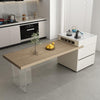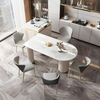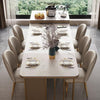The Top 10 Kitchen Island Trends You Need to Know

Introduction:
The kitchen island has become an essential element in modern kitchen design. Not only does it provide additional workspace and storage, but it also serves as a focal point for socializing and entertaining. In this article, we will explore the top 10 kitchen island trends that are shaping the way we design and utilize these versatile features.
Incorporating Smart Technology into Kitchen Islands
Smart technology has revolutionized the way we interact with our homes, and the kitchen is no exception. By incorporating smart features into kitchen islands, you can enhance functionality and convenience. Imagine controlling your kitchen appliances, lighting, and even music through voice commands or smartphone apps.
For example, installing smart appliances on your kitchen island allows you to preheat the oven, start the coffee maker, or adjust the stove temperature from the comfort of your seat. This not only saves time but also streamlines your cooking process. Additionally, integrating connectivity features like USB charging ports and wireless charging pads into your island creates a hub for all your electronic devices.

Multi-Level Kitchen Islands: Functionality and Style Combined
In today's modern kitchen design, multi-level kitchen islands have become increasingly popular due to their unique combination of functionality and style. These versatile islands offer distinct zones for various activities, making them a practical and visually appealing addition to any kitchen. Let's explore two specific features of multi-level kitchen islands: the raised breakfast bar or dining area and the lowered prep area or hidden storage.
Raised Breakfast Bar or Dining Area:
A raised breakfast bar or dining area on a kitchen island provides a designated space for casual dining and quick meals. This feature not only encourages interaction between the cook and guests but also optimizes the use of limited space in the kitchen.
Imagine starting your day with a cup of coffee and a quick breakfast at the raised bar of your kitchen island. It creates a cozy and relaxed atmosphere, allowing you to enjoy a meal while engaging in conversations or catching up on the latest news. This practical addition is particularly beneficial for busy individuals and families who appreciate the convenience of having a convenient dining spot within the kitchen.
Moreover, a raised breakfast bar or dining area adds an aesthetically pleasing element to the kitchen. It can be designed to complement the overall kitchen style, such as by incorporating matching countertops or utilizing contrasting materials for visual interest. This creates a seamless and cohesive kitchen design, with the island serving as a focal point that ties the space together.
Lowered Prep Area or Hidden Storage:
A lowered prep area on a multi-level kitchen island offers a practical and ergonomic workspace for meal preparation. By providing a lower surface for chopping, slicing, and other culinary tasks, it reduces strain on the back and promotes a more comfortable cooking experience.
Picture yourself effortlessly preparing ingredients on the lower area of your kitchen island. The ergonomic design allows you to maintain proper posture and work efficiently without putting excessive stress on your body. This feature is particularly appealing to avid cooks and those who spend a significant amount of time in the kitchen.
Additionally, multi-level kitchen islands often incorporate hidden storage solutions, which further enhance their functionality. You can utilize the space beneath the lowered prep area to discreetly store frequently used kitchen tools, pots, and pans. This not only keeps your countertop clutter-free but also ensures that essential items are within easy reach, streamlining your cooking process.
When planning a kitchen design with an island, consider the layout and size of your space. The placement and dimensions of the raised breakfast bar or dining area and the lowered prep area should be carefully considered to ensure optimal functionality and traffic flow within the kitchen. Consulting with a professional kitchen designer or contractor can provide valuable insights and assistance in creating a well-designed and efficient kitchen island.
In conclusion, multi-level kitchen islands offer a blend of functionality and style, elevating the overall kitchen design. Incorporating a raised breakfast bar or dining area encourages social interaction and maximizes space usage, while a lowered prep area provides ergonomic benefits for meal preparation. By combining these features, homeowners can create a kitchen island that not only meets their practical needs but also enhances the aesthetic appeal of their kitchen. When considering kitchen design with an island, remember to prioritize your preferences and consult professionals to achieve a kitchen that perfectly suits your lifestyle and culinary aspirations.
Industrial-Inspired Kitchen Islands: Embracing the Raw Aesthetic
Industrial-inspired kitchen islands have gained popularity for their raw and edgy aesthetic. By incorporating elements such as metal and exposed pipes, you can create a unique and visually striking centerpiece for your kitchen.
For example, a kitchen island with metal legs and a reclaimed wood top exudes a warehouse-inspired look. The combination of rough textures and natural materials adds warmth and character to the space, creating a welcoming atmosphere.
Additionally, incorporating distressed finishes and weathered patinas on the metal elements of your kitchen island adds a sense of history and authenticity. This design choice not only creates visual interest but also makes your island stand out from traditional, cookie-cutter options.
Minimalist Kitchen Islands: Simplicity in Design
In a world where "less is more" has become a popular design mantra, minimalist kitchen islands offer a sleek and streamlined look. Clean lines, minimal ornamentation, and a focus on functionality are the hallmarks of this trend.
For instance, a minimalist kitchen island with a monochromatic color scheme creates a cohesive and harmonious design. White or neutral tones paired with a simple, flat-panel shaker-style design for the cabinetry create a timeless and versatile aesthetic.
By decluttering the island surface and opting for hidden storage solutions, you can maintain a clean and uncluttered appearance. This not only enhances the visual appeal but also promotes an organized and efficient workflow in the kitchen.

Open Shelving on Kitchen Islands: Display and Storage Solutions
Floating Shelves for Easy Access and Decorative Displays
Open shelving on kitchen islands is a popular trend in kitchen design with islands. It offers a practical and visually appealing solution for both storage and display purposes. One variation of open shelving is the use of floating shelves, which not only provide easy access to items but also allow for decorative displays.
Floating shelves on the kitchen island create a sense of openness and airiness. They are typically attached to the side or back of the island, leaving the front part of the island unobstructed for meal preparation and other activities. This configuration allows for seamless movement and convenient access to frequently used items.
Imagine having your most-used cookbooks, spice jars, or decorative dishware neatly displayed on the floating shelves. Not only are these items easily accessible, but they also add a personal touch and visual interest to the kitchen. You can showcase your collection of vibrant spices, stylish dinnerware, or even potted herbs, creating a focal point on the island.
One of the advantages of floating shelves is their versatility in terms of customization. You can choose the length, width, and material of the shelves to match your kitchen design and personal style. For example, floating wooden shelves can add warmth and natural beauty to a traditional kitchen, while sleek metal shelves can enhance the modern aesthetic of a contemporary kitchen.
In addition to their decorative function, floating shelves on the kitchen island also provide practical storage solutions. You can use them to store everyday essentials, such as plates, bowls, and glasses, making them easily accessible while freeing up cabinet space. This is particularly useful for frequently used items that you want to keep within reach.
To make the most of the floating shelves, consider organizing items by category or color to create a visually pleasing arrangement. For example, group similar spices together, arrange dishes by size or color, or display a collection of decorative items in an aesthetically pleasing manner. This not only adds a decorative element to the kitchen but also facilitates efficient organization and easy retrieval of items.
It's important to note that while open shelving provides easy access and decorative displays, it also requires proper organization and maintenance. Dusting and cleaning the shelves regularly will keep them looking tidy and presentable. Additionally, it's important to strike a balance between displaying items and maintaining a clutter-free appearance. Avoid overcrowding the shelves, as it can make the kitchen look messy and overwhelming.
In conclusion, incorporating floating shelves on the kitchen island offers a practical and visually appealing storage solution. It allows for easy access to frequently used items while providing a platform for decorative displays that add personality and charm to the kitchen. Whether showcasing your favorite cookbooks, stylish dishware, or vibrant spices, the floating shelves on the kitchen island enhance the overall design and functionality of the space. So, consider incorporating this trend into your kitchen design with an island to create a beautiful and organized culinary hub.
Colorful Kitchen Islands: Adding a Pop of Personality
Gone are the days of monotonous kitchen islands. Adding a pop of color to your island can instantly elevate the style and personality of your kitchen.
For instance, a white kitchen with a bold blue island creates a striking contrast and becomes the focal point of the room. The vibrant blue color adds a sense of energy and liveliness, making a bold design statement.
Consider coordinating the color of your island with other elements in the kitchen, such as backsplash tiles or cabinet hardware, to create a cohesive and harmonious look. This color coordination ties the design together, creating a visually pleasing and balanced space.
Statement Lighting for Kitchen Islands: Illuminating the Space
Statement lighting fixtures above the kitchen island not only provide functional task lighting but also serve as eye-catching design elements.
For example, oversized pendant lights with unique shapes and finishes draw attention to the island, creating a focal point in the kitchen. These fixtures not only provide ample lighting for food preparation but also add a touch of elegance and sophistication to the space.
Chandeliers or other unique light fixtures can also be used to make a statement above the kitchen island. This creates a sense of luxury and grandeur, transforming the island into a centerpiece that enhances the overall aesthetic of the kitchen.
Waterfall Edge Kitchen Islands: A Sleek and Modern Look
Waterfall-edge kitchen islands have gained popularity for their sleek and seamless appearance. This design feature involves the countertop material flowing down one or both sides of the island, creating a continuous and visually striking look.
For instance, a kitchen island with a waterfall edge in contrasting materials, such as marble or quartz, adds a touch of luxury and modernity. The clean lines and smooth surfaces create a minimalist aesthetic that is both visually appealing and easy to clean.
Alternatively, using acrylic or glass materials for the waterfall edge creates a transparent and ethereal look. This choice adds a unique and contemporary element to the kitchen, making the island a true conversation piece.

Sustainable Materials for Kitchen Islands: Eco-Friendly Choices
With the growing emphasis on sustainability and eco-friendly design, using sustainable materials for kitchen islands has become a significant trend.
For example, a kitchen island with a countertop made from bamboo or cork offers a renewable and environmentally friendly option. These materials not only add warmth and texture to the space but also contribute to reducing the carbon footprint.
Using recycled glass or concrete composite materials for the island's countertop is another sustainable choice. These materials offer durability and unique visual patterns while minimizing the use of natural resources.
Customizable Kitchen Islands: Tailoring to Individual Needs
Customizable kitchen islands allow homeowners to tailor their islands to their specific needs and preferences. This trend emphasizes functionality, personalization, and maximizing the island's potential.
For instance, a kitchen island with built-in seating or a banquette provides a comfortable and casual dining space. This feature is especially beneficial for small kitchens where space is limited.
Hidden storage solutions, such as pull-out drawers or shelves, can be incorporated into the kitchen island. This allows for efficient organization and decluttering, ensuring a clean and tidy workspace.
Practical applications of these trends can be seen in various real-life examples. For instance, a kitchen design featured in "Architectural Digest" combines a white shaker kitchen with a navy blue island, creating a timeless and visually appealing contrast. Another example can be found in "Better Homes & Gardens," where a sage green kitchen island adds a touch of freshness and tranquility to the space.
Conclusion:
In conclusion, as you have explored the top 10 kitchen island trends, you now have a comprehensive understanding of how these trends can transform your kitchen island into a functional and stylish centerpiece. At DPhome, we not only provide high-quality products but also offer professional guidance throughout the entire process, from selecting the perfect kitchen island to placing your order, arranging delivery, and assisting with installation and usage. Our aim is to provide a seamless and comprehensive service that caters to your specific needs and preferences. So, if you're ready to enhance your kitchen with a trend-setting island, choose DPhome for top-notch products and expert guidance every step of the way.
FAQs:
-
What are the top trends in kitchen island design? The top trends in kitchen island design include incorporating smart technology, multi-level designs, industrial-inspired aesthetics, minimalist designs, open shelving, vibrant colors, statement lighting, waterfall edges, sustainable materials, and customizable options.
-
How can I incorporate smart technology into my kitchen island? Smart technology can be incorporated into your kitchen island in a number of ways. You could install smart appliances that can be controlled remotely, integrate USB charging ports and wireless charging pads, or even include smart lighting that can be adjusted to suit your mood and activities.
-
What is the advantage of having a multi-level kitchen island? A multi-level kitchen island offers both functionality and style. It provides distinct zones for various activities, such as a raised area for dining and a lower area for food preparation or storage. This makes it a practical and visually appealing addition to any kitchen.
-
How can I add a pop of color to my kitchen island? You can add a pop of color to your kitchen island by choosing a bold color for the island that contrasts with the rest of your kitchen. For example, a vibrant blue island in a white kitchen can create a striking focal point. Consider coordinating the color of your island with other elements in the kitchen for a cohesive look.
-
What are some sustainable materials I can use for my kitchen island? Sustainable materials for kitchen islands include bamboo or cork for countertops, as they are renewable and eco-friendly. Other options include recycled glass or concrete composite materials, which offer durability and unique visual patterns while minimizing the use of natural resources.
-
Posted in
island table





